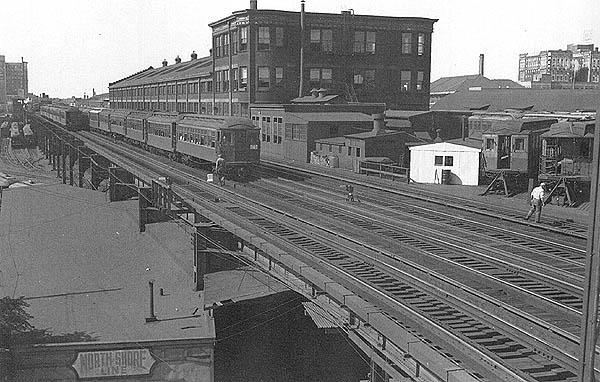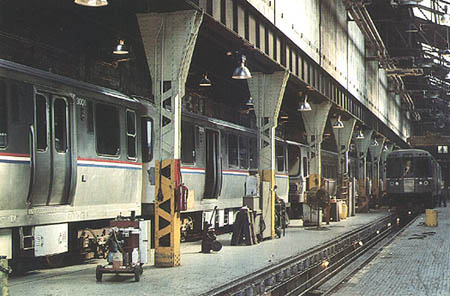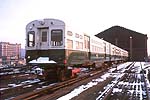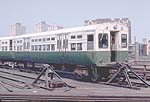
The Wilson Shops, as seen
looking north from Montrose Avenue. The Lower Wilson Yard
can be seen at grade in the background. Just about
everything in this view - the wooden cars, the upper and
lower yards, the shop building, the North Shore Line parcel
dispatch building in the lower left - are gone today.
(Photo from the Charles E. Keevil
and Walter R. Keevil Collection)
|
Wilson Yard &
Shops
Sunnyside Avenue and
Broadway, Uptown
Service
Notes:
|
Located:
|

|
Red Line:
Howard
|
Quick Facts:
Address: 1036 W. Montrose
Avenue
Established: 1901
Shop Area: 39,205 square feet
Yard Area: 105,200 square feet
Rebuilt: n/a
Status: Burned, Demolished
Like the other three main "L" companies, the Northwestern Elevated
planned to build its chief maintenance facility and storage yard at
the end of its line at Wilson
Avenue. To maximize storage capacity on what was a relatively
small space, the Northwestern built a two-level complex between
Montrose and Wilson. A four-track brick shop (whose upper stories
also housed the company's offices) and small storage yard were built
on an elevated steel structure, at track level. Below, a second
"lower" yard was constructed, connected to the elevated main line by
two ramps.
By mid-1900, the Wilson Yard had been completed, but work was just
beginning on the massive four-track, three-story shop building. By
the end of the year, the complex was mostly complete. The shop opened
in 1901.
A loop track was added to the lower yard in 1907 and a small
stucco station was added, acting as an auxiliary to the main
Wilson station. The loop was
laid out such that train leaving the platform could go all the way
around and proceed southbound for another trip, or enter the yard.
Express trains utilized the lower station.
The Wilson Shops continued to be used for over 90 years, through
many changes in services. In 1906, the Ravenswood branch opened,
followed by the Evanston extension in 1908 and the Niles Center
branch in 1925. Although some small yard and shop facilities were
built at Kimball and Linden,
followed by a small yard at Howard in 1919,
Wilson remained the main maintenance and storage facility for the
North Side Division. In 1949, the Lower Wilson
station ceased to the used for revenue operations, but the lower yard
remained in use for some time. But by the mid-1970s (through probably
a good deal earlier), the lower yard had been demolished and the
connection severed.
In 1949, the practice of ending some runs at Wilson
ceased and all trains were run through to Howard.
This made the mid-line location of the Wilson Yard and Shop less than
ideal, besides the fact that the facility was rapidly aging.
In 1960, the shop received a $36,500 improvement project, getting
a facelift of sorts. The upper row of windows on the exterior were
bricked in. The original small-paned window sash along the lower
trackside part of the exterior was removed in favor of glass block
windows with a single row of clear windows along the bottom.
Supposedly, the new windows would allow more daylight into the shop
and make the interior less drafty, cutting down on the amount of heat
that escaped through the old windows. A new heating system was also
installed under the project in 1959.
By the 1990s, the facility was cramped and ill-suited to the
performance of some maintenance on the more sophisticated modern "L"
cars. As part of the impending through-routing of Howard service with
the Dan Ryan (it has previously been run south to Englewood-Jackson
Park), a plan was formulated to expand and modernize the Howard
Yard and build a new, state-of-the-art Howard
Shop.
The new Howard facility opened in 1993
and the main maintenance and storage functions for the North-South
Route were moved from Wilson to Howard.
Wilson continued to be used for auxiliary purposes, but the shop
building fell victim to a fire and burned down on October 26, 1996.
The site was cleared soon thereafter. Today, only a few sidings from
the north end of the yard remain.
Wilson Yards Redevelopment
As Uptown began to redevelop in the late-1990s, private
development schemes were quickly contemplated on the former shop and
yard site, a sizable piece of property. The Wilson Yard Redevelopment
Task Force was established in 1997 to discuss the feasibility of the
development of the yard site, for which a Tax Increment Financing
(TIF) district was created circa 2001 to help spur and fund
development on and around the property. A Request for Qualifications
(RFQ) for the Purchase and Redevelopment of the site was issued in
April 2002 and the City of Chicago designated a partnership between
Chicago developers Holsten Real Estate Development Corp. and Kenard
Corp. as developer for the Wilson Yard site in Fall 2002. 46th Ward
Alderman Helen Shiller presided over a four year community planning
process in which residents advocated for widely-diverging ideas of
what the former yard site should be used for. Ultimately, Holsten
developed a mixed-use development project for the site, including a
"big box" store, a cinema, affordable and senior housing, a new Aldi
store, ground-floor retail, and offices on upper floors.
On December 16, 2004, the Chicago Transit Board authorized the
sale of property at the former Wilson Yard to the City of Chicago at
the market rate price of $6.6 million. The City of Chicago will, in
turn, sell the property to Holsten to develop the property. In
addition to the sale of the property, the
CTA® agreed to pay up to
$750,000 for environmental remediation of the property. The money
will come out of the sale of the property and be held in escrow to
assist the City and the developer. The $6.6 million sale helped add
revenue to the CTA's® operating
budget which, at the time of the sale, was facing a deficit due to an
imbalance in regional funding.
At the time of the sale, the 164,000 square foot property still
contained a CTA® maintenance
shop and outdoor storage areas. The maintenance shop and storage
areas will be relocated to other
CTA® properties. As part of the
terms of the sale, the CTA®
will retain permanent easement rights necessary in order to have
access for activities related to operations and maintenance of Red
Line service and track structure.
In mid-January 2005, the City Council approved a zoning change for
the entire site of the long-debated, $113 million mixed-use Wilson
Yard development project. The project was to be introduced to the
City Council Finance Committee in February 2005.
According to the Chicago Tribune, Holsten plans to begin
construction of a new Aldi grocery store at the north end of the site
on vacant land that is just south of the McJunkin Building. Aldi
operated a store in the middle of the development site, which needed
to be demolished so other parts of the project could be built. Once
Aldi has relocated, Holsten planned to demolish the existing Aldi
building and a vacant building to the south of it, and begin building
three structures:
- A nine-story, 72-unit seniors building will go up over
ground-floor retail space on Montrose just west of Broadway.
Holsten will partner with Providence Rest Haven Illiana Housing to
build that structure.
- A nine-story rental building will rise on the northwest corner
of Montrose and Broadway and will have 70 affordable one- to
three-bedroom apartments with 800 to 1,200 square feet of space.
Holsten is partnering with Chicago-based Morgan Group on the
rental building.
- A seven-story commercial building will go up along Broadway
between Montrose and Sunnyside Avenue, and will have a
198,000-square-foot Target store on the first floor and a
12-screen, 2,000-seat movie theater complex on the second. A
426-car garage will occupy the building's third through seventh
floors. They will also have 15,000 square feet of ground-level
small retail spaces along Broadway, and will look for a
combination of local and national retailers to lease those
spaces.
In February 2006, Kerasotes ShowPlace Theatres LLC dropped its
plans to open a 12-screen movie theater in the Wilson Yards
development, stating that construction costs would be too high.
"Whenever you build up, it's a lot more expensive," said Tony
Kerasotes, the movie chain's CEO in Crane's Chicago Business.
The movie theater would have cost about $24 million to build, but
Kerasotes' financial projections would only justify a cost of about
$18 million, said Holsten President Peter Holsten.
So, Holsten Real Estate Development Corp. is moving forward
without a theater. Without a theater, Holsten will be able to add
about 8,000 square feet of street-level retail space to the project.
Target Corp. may also put parking on top of its store instead of
underground, as it originally planned.
Chicago-based FitzGerald Associates designed the Wilson Yard
development project. Holsten aims to begin construction by the end of
2006. Holsten's first construction phase will be a new Aldi grocery
store on vacant land just south of the McJunkin Building (4554 N.
Broadway, at the north end of the development site). After moving
Aldi's from the McJunkin, the developer will begin the rest of the
construction.

Inside the Wilson Shops, the
1900-vintage facility services its fourth generation of
rolling stock. In this October 22, 1991 view, cars
3001-3002, 2919-2920 and a pair of 2000s
are being serviced. (Photo by Art
Peterson)
|


|
wilson02.jpg
(43k)
CRT car 1005 (formally Northwestern car 5) is on a hoist at
Wilson Shops. (Photo from the CTA
Collection)
|

|
wilson04.jpg
(155k)
Wilson Yard is seen looking northeast in 1967 from the North
Side Main Line south of the shops, seen on the left. The
tracks in the foreground originally provided a south
entrance to the yard from the main line, but were severed in
the years after the
CTA® assumed control
of the "L". By the 1960s and early 1970s, Wilson Yard mostly
houses equipment for Evanston Express and Ravenswood tripper
trains. (Photo by Miles Beitler)
|

|
cta6003wilson.jpg
(60k)
Car 6003 is seen here on November 29, 1977 at Wilson Shops,
already out of service and awaiting to go to Skokie
Shops. The shop building, now gone, can be seen in the
background. (Photo by Peter
Vesic)
|

|
cta6212.jpg
(120k)
Car 6212 sits in the Wilson Yard between assignments on May
28, 1978. (Photo by Ed McKernen, Collection
of Joe Testagrose)
|








